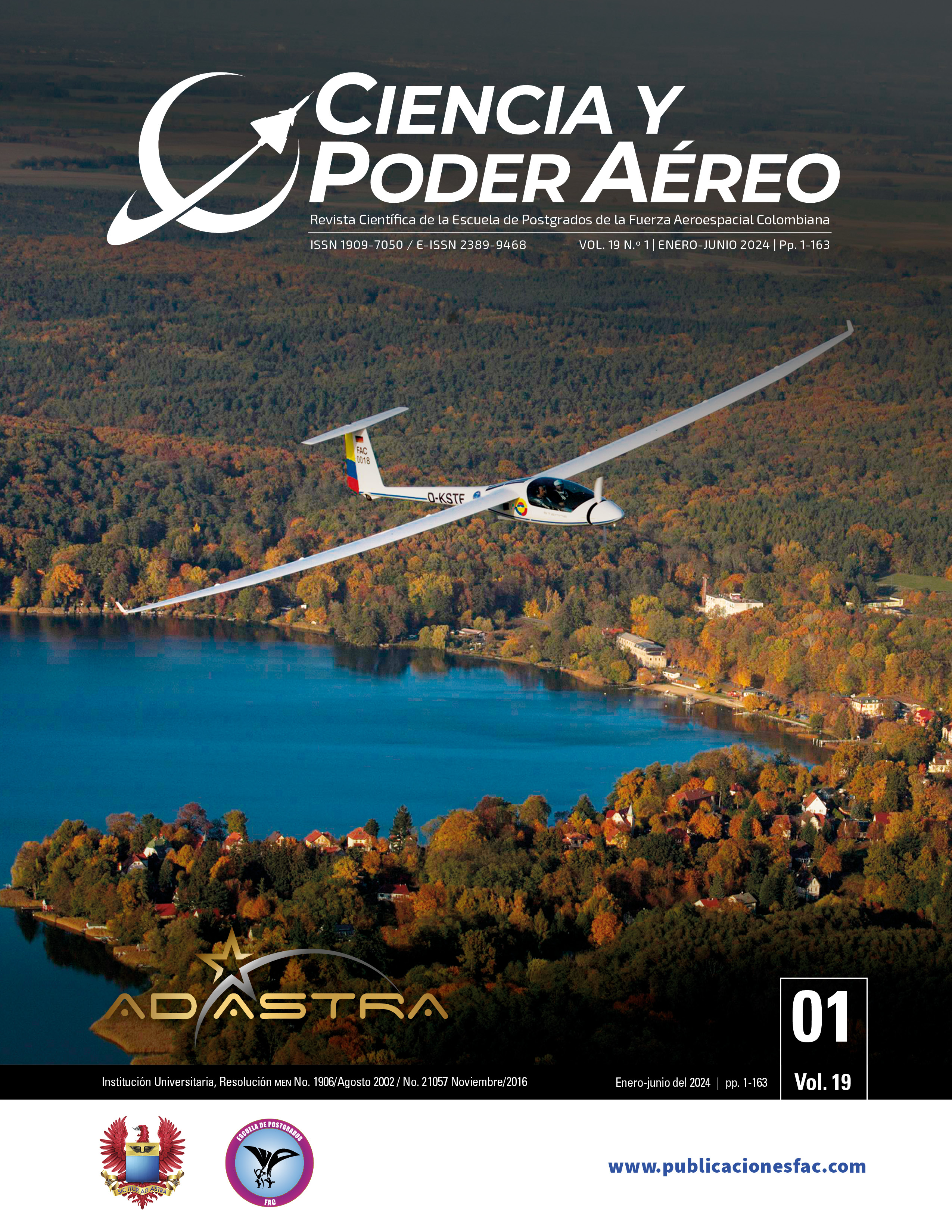Icing in aircraft: a challengefor safety and air efficiency
DOI:
https://doi.org/10.18667/cienciaypoderaereo.786Keywords:
icing aircraft, ice formation mechanisms, effects of icing on the aircraft, , icing prevention and mitigation strategies, technological advancements in icing preventionAbstract
Aircraft Icing is a complex and potentially dangerous phenomenon that occurs when the surface of an aircraft becomes covered in ice during flight in adverse weather conditions. This process can have serious implications for the safety and performance of aircraft, affecting aerodynamics, stability, and control.
This work aims to analyze ice formation mechanisms in aircraft, classify and characterize types of icing, evaluate atmospheric conditions for ice formation, identify vulnerable critical zones to icing, explore icing prevention and mitigation strategies, and compare ice protection systems. By achieving these objectives, a thorough and comprehensive understanding of the icing phenomenon in aircraft is expected to be obtained, ranging from its mechanisms to strategies for its prevention and mitigation.
Downloads
References
Adsuar, J. C. (2003). Meteorologia: Conocimientos Teóricos Para la Licencia De Piloto (2nd ed.). Madrird: Ediciones Parainfo.
Alemán, J. J., & Alomar, M. (2011). Convección atmosférica. Madrid: Asociación Canaria de Meteorología.
Andreev, G., & Bogatyrev, V. (2014). INVESTIGATION OF ICING EFFECTS ON AERODYNAMIC CHARACTERISTICS OF AIRCRAFT AT TSAGI. 29th Congress of The International Counsil of the Aeronautical Sciences, (p. 9). Petersburg.
Ayón, A., Salomón, J., Llanes, J., & Sierra, L. (2022, noviembre 07). Pronóstico de engelamiento de aeronaves en la región de información de vuelos de Cuba. Ingeniería Energética. Tomado de: http://scielo.sld.cu/scielo.php?script=sci_arttext&pid=S1815-59012022000300048&lng=es&tlng=pt.
Cáceres, R. (2017). Meteorología aplicada a la seguridad de las operaciones aéreas. Bogotá, D.C.: Escuela de Postgrados de la Fuerza Aérea Colombiana.
Comandancia Departamento del Ejército Washington. (1982). Meteorología para Aviadores Militares. Manual de Operaciones N° FM 1-230., DC, 14.1- 14.19.
Cuesta, M. (1991). REVISTA DE AERONAUTICA Y ASTRONAUTICA. Tomado de Cinco condiciones ambientales adversas para el vuelo: https://www.divulgameteo.es/fotos/meteoroteca/5-condiciones-adversas.pdf
EASA. (2017). Formación de Hielo en Vuelo. GA10. Retrieved from https://www.easa.europa.eu/en/downloads/24118/es#:~:text=Cuando%20en%20una%20aeronave%20una,general%2C%20es%20f%C3%A1cil%20de%20ver.
Espinosa, J. (2019). Nucleación de sólidos cristalinos por simulación.Madrid, Tomado de:https://dialnet.unirioja.es/servlet/tesis?codigo=230047.
FAA. (2015). AC 91-74B, Pilot Guide: Flight in Icing Conditions. EEUU.Tomado de chrome-extension://efaidnbmnnnibpcajpcglclefindmkaj/https://www.faa.gov/documentlibrary/media/advisory_circular/ac_91-74b.pdf
Jeck, R. K. (1983). A New Data Base of Supercooled Cloud Variables for Altitudes up to 10,000 Feet AGL and the Implications for Low Altitude Aircraft Icing. Washington, D.C: FAA.
Landsberg, B., Murphy, K., Bell, L., Ells, S., & Hummel, K. (2004). Aircraft Deicing and Anti-icing Equipment. Maryland, USA: AOPA Air Safety Foundation.
Li, S., Qin, J., He, M., & Paoli, R. (2020). Fast Evaluation of Aircraft Icing Severity Using Machine Learning Based on XGBoost. Aerospace, 18.
Ma, L., Zhang, Z., Gao, L., Liu, Y., & Hu, H. (2021). Bio-Inspired Icephobic Coatings for Aircraft Icing Mitigation:A Critical Review. Progress in Adhesion and Adhesives, Vol. 6, 171-201.
Moreno, N. (2019). Estructura metodológica para el estudio de imágenes satelitales en la identificación de nubes convectivas que surgen en la aviación. Retrieved from http://hdl.handle.net/11349/22529.
Pruppacher, H., & Klett, J. (2010). Microphysics of Clouds and Precipitation. Springer Science & Business Media.
Retallack, B. J. (1974). Compendio de Meteorología. Voll. II Parte 2. Meteorología aeronáutica. Organización Meteorológica Mundial (OMM).
Shi, L., Feng, F., Guo, W., & Li, Y. (2021). Research and Development of a Small-ScaleIcing Wind Tunnel Test System for Blade Airfoil Icing Characteristics. International Journal of Rotating Machinery, 12.
Švancárová, N., & Jarošová, M. (2022). Impact of clouds on the aviation,Práce a štúdie. University of Žilina.
Tan, W., Cao, Y., & Wu, Z. (2017). Aircraft icing: an ongoing threat to aviation safety. Aerospace Science and Technology.
Vivas, E. O. (2016). ¿Cómo afecta el hielo el vuelo de un avión?. TecnoESUFA: Revista De tecnología aeronáutica, 24. Retrieved from.: https://publicacionesfac.com/index.php/TecnoESUFA/article/view/511
Wei, K., Yang, Y., Hongyan, Z., & Zhong, D. (2019). A review on ice detection technology and ice elimination technology for wind turbine. Wiley, 25.
Wu, Z., & Cao, Y. (2013). Numerical simulation of airfoil Aerodynamic Penaltiesand Mechanismsin Heavy Rain . Advances in Mechanical Engineering, 13.
Downloads
Published
Issue
Section
Categories
License
Copyright (c) 2023 Escuela de Postgrados de la Fuerza Aérea Colombiana

This work is licensed under a Creative Commons Attribution 4.0 International License.
Assignment of Copyrights
Authors assign Ciencia y Poder Aéreo journal the exclusive rights (reproduction, distribution, public communication, and transformation) to exploit and commercialize their work, in whole or in part, in all the formats and modalities of present or future exploitation, in all languages, throughout the life of the work and throughout the world.
All contents published in Ciencia y Poder Aéreo journal are licensed under a Creative Commons Attribution 4.0 International License, whose complete information is available at http://creativecommons.org/licenses/by/4.0/
Under the terms of this license, users are free to download, print, extract, archive, distribute and publicly communicate the content of articles, provided that proper credit is granted to authors and Ciencia y Poder Aéreo, scientific journal of the Graduate School of the Colombian Air Force. Except when otherwise indicated, this site and its contents are licensed under a Creative Commons Attribution 4.0 International License.
For other uses not considered under this license it is required to contact the Director or the Editor of the journal at the e-mail address cienciaypoderaereo1@gmail.com.
The Graduate School of the Colombian Air Force and this publication are not responsible for the concepts expressed in the articles, including the metadata or the affiliation stated by authors. This is the full responsibility of the authors.






















